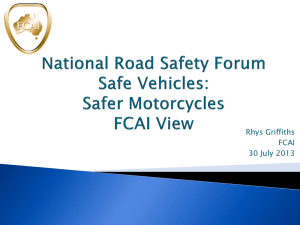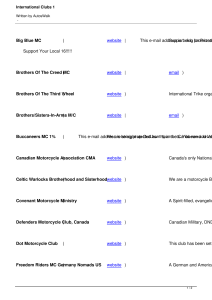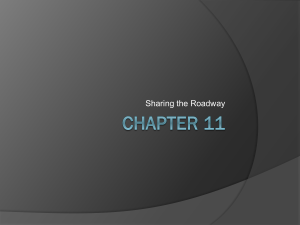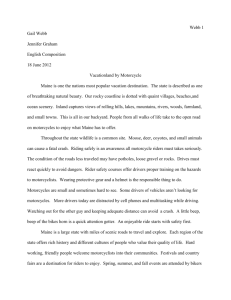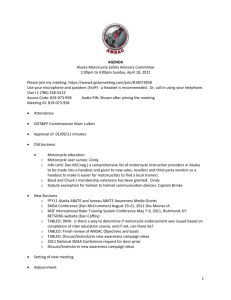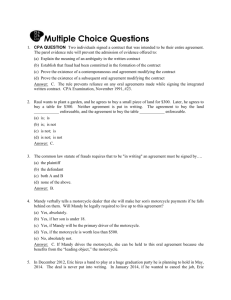Motorcycling in Australia
advertisement
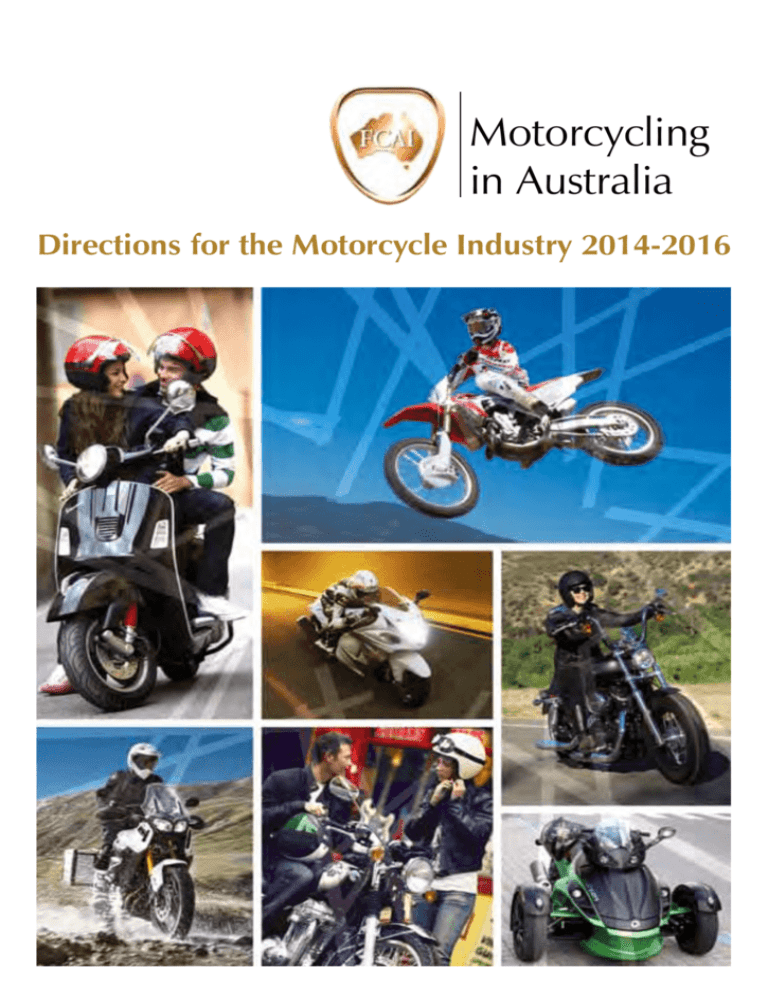
Motorcycling in Australia Directions for the Motorcycle Industry 2014-2016 Motorcycling in Australia Scope of the Industry Analysis Directions for the Motorcycling Industry 2014–2016 This document has been prepared by the Federal Chamber of Automotive Industries’ Motorcycle Group. It outlines a range of issues affecting motorcycling in Australia and sets out directions to be taken by the industry over the next three years (2014-2016). These will reinforce the status of motorcycling as an important transport mode offering significant benefits to regulators, planners, and communities, and to the riders themselves. The document is relevant to the importers and retailers who constitute the motorcycle industry, government agencies (from national regulators to local planners), and stakeholders in related industries – in fact, anyone with an interest in motorcycling. FCAI – the Federal Chamber of Automotive Industries FCAI is the peak industry organisation representing manufacturers and importers of passenger vehicles, light commercial vehicles, and motorcycles in Australia. This document is concerned with twowheeled vehicles – motorcycles (both road and off-road) and scooters (smaller vehicles with a step-through frame and a floor for the rider’s feet). These machines are sometimes referred to as Powered Two Wheel vehicles (PTWs). One in five of the vehicles sold in Australia that are classed as “motorcycles” are All-Terrain Vehicles (ATVs). Almost all of these are fourwheeled vehicles which are mainly used on rural properties. ATVs are not included in this analysis of the motorcycle industry. There is also a small number of threewheeled motorcycles (trikes) entering the market and being used on the public roads. These are discussed in the “New Technology” section on page 11. The manufacturers represented in the Motorcycle Group are: BMW Motorcycles Australia BRP Australia Pty Limited [Can-Am, BRP] Harley-Davidson Australia Pty Limited Honda Australia Pty Limited John Sample Automotive Pty Limited [Aprilia, Moto Guzzi] Kawasaki Motors Pty Limited KTM Australia KYMCO Australia NF Importers [Ducati] Peter Stevens Importers [Triumph, Hyosung, Vespa, Gilera, Piaggio] Suzuki Australia Pty Limited Victory Motorcycles [Victory, Indian] Yamaha Motor Australia Pty Limited Issued November 2013 If you would like more information about the issues discussed in this document, please contact: Federal Chamber of Automotive Industries 59 Wentworth Avenue Kingston ACT 2604 02 6247 3811 www.fcai.com.au The Australian Motorcycle Industry A Vision for Australian Motorcycling Motorcycling is a smart and affordable way to travel, ideally suited to the Australian lifestyle. Motorcycles come in many styles and sizes from trail bikes to cruisers to touring bikes to scooters. They have lower travel costs, produce less CO2 emissions, reduce travel time and traffic congestion in urban areas, and use valuable inner-city parking space more effectively. The smaller, more efficient engines also have less impact on urban air quality. Riding motorcycles and scooters encourages outdoor activity and a healthy lifestyle. Motorcycling in Australia – • Offers an affordable, accessible, and sustainable mode of transport • Can provide significant but often overlooked benefits in transport policy and urban planning • Provides a variety of sporting and recreational opportunities and promotes a healthy outdoor lifestyle • Makes a significant contribution to national economic activity This document sets out a number of key issues to be considered and addressed by governments at all levels, the wider community, and the motorcycle industry itself in order to ensure this vision is achieved: • Transport policy and urban planning (page 3) • Energy efficiency and emissions policies (page 4) • Motorcycling safety policies and programs (page 5) • Motorcycling safety perceptions (page 8) • Support and promotion of motorcycle sport and recreation (page 9) • Recreational off-road licensing and designated land use (page 10) • Design standards and new technology (page 11) • Industry relationships (page 12) The Australian Market There are more than 40 brands of motorcycles and scooters imported into Australia. They are sold by approximately 700 authorised dealers across Australia, supported by more than 2000 other motorcycle-related businesses such as workshops and sellers of clothing and accessories. Motorcycling employs nearly 15 000 people, either directly or indirectly, and contributes $3.6 billion each year to the Australian economy. In 2012 nearly 92 000 new motorcycles and scooters (excluding ATVs) were sold; 41% of these were off-road bikes. Adding used motorcycle sales takes this annual total to about 200 000 motorcycles. Motorcycling in Australia • More than one million motorcycles • 200 000 new and used sales each year • More than 40 brands imported • 700 authorised dealers • 2000+ related businesses • Contributes $3.6 billion to the national economy • 15 000 people employed • 800 000 motorcycle licence holders • 678 000 registered motorcycles • 47 500 sport or single event licences • 3500 motor sport events each year Federal Chamber of Automotive Industries: Motorcycling in Australia 2014-2016 1 This total is based on importers who choose to report their sales in combination with registration figures obtained from the state authorities. There are a number of imported motorcycles (mainly smaller capacity non-registerable motorcycles imported from Asia) that are not included in these official figures. On current estimates about 30 000 of these motorcycles were brought into Australia in 2012. The estimated total “park” of motorcycles in Australia (ie, vehicles registered for use) is currently in excess of one million motorcycles. In addition it is estimated that there are approximately twice as many offroad motorcycles in operation as those on-road. Motorcycle Riders People of all ages and from all walks of life ride motorcycles. Mini-bikes allow children to be introduced to motorcycling at a very young age. They are able to enter motorcycle sports as young as age seven which helps build skills and responsibility. At the other end of the scale, mature-age riders have the time and money to enjoy recreational riding and touring. SA Ambulance Service’s Motorbike Response Unit Essential & Commercial Services The combination of manoeuvrability, ease of parking, and ability to cover larger distances at speeds equivalent to cars make motorcycles the ideal vehicle to be put to work in the urban environment. We have been long accustomed to seeing police officers and posties on motorcycles providing essential services which cannot be done effectively or economically by other vehicles. It is not about speed, it is about safe and timely access to emergency patients In March 2012, the SA Ambulance Service introduced the Motorbike Response Unit (MRU) which has proven to be highly successful. The MRU can easily negotiate heavy traffic and built up areas to quickly gain access to patients. Motorbikes, along with other first responder vehicles such as SPRINT cars and bicycles, are fully equipped emergency response vehicles. This means senior paramedics can provide a patient with lifesaving treatment whilst an ambulance with patient-carrying capabilities is on the way. Seconds count in emergency medical situations: the sooner that patients receive lifesaving treatment, the better their chances of survival. There are about 750 000 – 800 000 motorcycle licence holders in Australia and around 678 000 registered motorcycles [ABS: 2011]. Motorcycling – A Part of the Community Motorcycle sport and recreation is popular with an estimated 3500 events each year conducted by Motorcycling Australia (MA), the national body for organising motorcycle racing around the country. About 21 000 motorcycle sport riders hold a full racing or competition licence – another 27 500 single event competition or recreational licences are issued each year. These events contribute millions of dollars to the economy, particularly in regional and rural areas. International motorcycle events bring visitors to Australia and local municipalities. Currently Australia hosts rounds of both the World MotoGP and World Superbike championships; from time to time, other international motorcycle events are held in Australia such as Speedway World Championships, Trials World Championships and Motocross World Championships. Other world-recognised events include the Australasian Safari and the annual Finke Desert Race (500 entrants and at least three times as many support crew). The Ulysses AGM (3000 – 5000 older riders participate) and Junior Motocross Championships (700 entrants and over 1000 family members for support) are just two more examples of hundreds of community events run every year by motorcyclists. There is a major contribution to society from motorcycle-related events such as the “Snowy Ride” (which raises funds for the Steven Walter Children’s Cancer Foundation) and the many Toy Runs in each state which collect toys and goods for the less fortunate in our society. In addition to motorcycles for sport and recreation, nearly every farm in Australia has one or more motorcycles of some description and motorcycles are a familiar sight on our streets – from the small motorcycles Australia Post uses to deliver mail throughout city and regional areas to the powerful machines used on roads and highways by police patrols. The “last kilometre” in delivering goods and messages in the CBD is extremely important to the city’s services and businesses: motorcycles are an intermediate solution between bicycle couriers and light commercial vehicles. Items now being delivered by motorcycle include fast food, medical supplies and samples, and spare parts. However, there is significant potential within Australian urban areas for the greater use of motorcycles. 2 Federal Chamber of Automotive Industries: Motorcycling in Australia 2014-2016 Motorcycles in Transport Policy & Urban Planning Motorcycling offers significant benefits in managing traffic and in urban planning and therefore warrants greater attention in the development of transport policies. Motorcycles have significantly less impact on roads than any other type of vehicle which means infrastructure assets last longer. However, most strategies focus on walking, cycling, and public transport, and make only cursory mention of motorcycling. To avoid future congestion, the municipality’s road network needs to be optimised for the more space-efficient modes, including ... significantly better priority for space efficient vehicles at traffic lights especially trams, buses and pedestrians. Road space efficiency can also be achieved by lower speed limits, encouraging the use of more compact cars and vans, and the increased use of motorbikes and scooters. [City of Melbourne Transport Strategy 2012] Transport Options Motorcycling provides a low cost and flexible means of medium to long distance travel enhancing social inclusion whereas public transport is limited in the areas served and the hours of operation while cycling, even for dedicated cyclists, is only a viable option for relatively short-distance commuting. An integrated transport strategy should recognise the role and advantages of motorcycling in areas of maximum density (inner-city and suburban centres); on arterial and main suburban roads; and for inter-city travel on freeways and motorways. Motorcycles are the only other transport mode capable of travelling at highway speeds. Motorcyclists enjoy increased mobility and reductions of up to 48% in travel times ... and they spend less time looking for parking spaces [The Motor Cycle Industry Association, UK, The Case for Motorcycling, June 2011] Traffic Management Greater use of motorcycling has the potential to offer significant benefits to commuters and the business community. Motorcycles – • Take up less space and can take up to 48% less time to cover the same trip through congested traffic as a car • Move more freely and are less likely to be caught in gridlocks; if a motorcycle breaks down, it does not block traffic • Are better able to clear intersections and avoid traffic problems which benefits all road users Full integration of motorcycles into urban traffic management would see motorcyclists able to use bus transit or priority lanes, and other real estate for both movement and parking. Encouraging urban motorcycle use would have benefits for all road users. Parking Motorcycle parking can be provided in smaller spaces which cannot be used by motor cars: this includes verandahs and other small spaces on private property, reducing the need for or impact on street parking in residential areas or at transport interchanges, a particular advantage when planning transit-oriented developments (TODs). Currently Melbourne is the only capital city in Australia where a motorcycle can be legally parked on the footpath. In addition, within the Melbourne CBD, more than 300 on-road parking spaces have been designated specifically for motorcycles. Five motorcycles can park in the space normally allocated to one motor car [The Motor Cycle Industry Association, UK, The Case for Motorcycling, June 2011] FCAI will continue to promote the benefits to the community of motorcycling to ensure it is given greater weight in transport policy and urban planning Federal Chamber of Automotive Industries: Motorcycling in Australia 2014-2016 3 Motorcycling: Energy Efficiency & Emissions Motorcycling offers significant benefits in emissions reduction and local air quality. • Motorcycle journeys are quicker and motorcyclists spend less time stuck in traffic • Motorcycle engines are smaller and therefore inherently fuel efficient • Motorcycles produce lower emissions of both CO2 and other pollutants per kilometre of travel Greater use of motorcycles has the potential to make a contribution to reducing the harmful emissions created overall by the transport sector. In 2011, the Australian average CO2 emissions for passenger and light commercial vehicles was 206 g/km. European studies show an average for motorcycles of 110 g/km; smaller machines average 70 g/km. Fuel consumption for smaller capacity motorcycles and scooters can often be as low as a couple of litres per hundred kilometres. Embedded Energy The finite resources that are required to produce, distribute to point of sale, and ultimately recycle (or dispose of) a motorcycle are far less than for a car. Ultimately less resources are required to manufacture a motorcycle, which is able to transport one or two people, than a car. In addition, over its lifetime, a motorcycle will burn less fossil fuel, take up less space, and deliver its rider more efficiently in congested traffic. This leads to a strong environmental argument for the expanded use of motorcycles and scooters in the modern metropolitan area. Efficiency Standards Motorcycles reduce fuel use and emissions for Australia Post With more than 10 000 vehicles, Australia Post has one of Australia’s largest transport fleets; however, 70% of these vehicles are motorcycles. They are critical in achieving Australia Posts’s goals for reducing its fuel consumption and greenhouse gas emissions. Motorcycles have been used by Australia Post since the 1970s and they travel more than 60 million kilometres each year, delivering mail to many Australians in towns and cities. Australia Post also has a strong commitment to rider safety through a program of rider training, the use of high visibility clothing and panniers, and regular maintenance inspections. Motorcycles complying with relevant Australian Standards and Design rules should be able to meet any emissions targets in the short to medium term. However, current transport policies do not include emission targets for motorcycles. The need to lower emissions and develop more efficient engines is being driven by agencies in the Northern Hemisphere and this will result in further significant improvements. However, if more stringent targets for emissions, safety, or other aspects are contemplated in Australia, government agencies need to be aware that all motorcycles sold here are imported and the Australian market only represents a very small percentage of global production. Electric Vehicles A new sector is being developed to bring electric-powered motorcycles (e-cycles) to the market. At the point of use, these vehicles have zero emissions. The infrastructure required for other electric vehicles will also be suitable for e-cycles and so the industry will be able to take advantage of any developments in the medium to long term. FCAI will continue to encourage the use of motorcycles to reduce urban traffic congestion, overall fuel usage, and emissions of the transport fleet – Australia Post Corporate Responsibility Report 2009-10 4 Federal Chamber of Automotive Industries: Motorcycling in Australia 2014-2016 Motorcycling Safety: Policies & Programs 55% of serious casualty crashes involve another vehicle and in 57% of these crashes the motorcyclist was not at fault [SA Motorcycling Road Safety Strategy, 2005-2010]. Education and enforcement must therefore target all road users. Training Training and testing practices have developed independently in each Australian state and territory. Consequently there is a wide variation in the programs delivered and the skills tested. Government agencies often question the safety benefits of training; however, there is an increasing trend for licensing bodies to encourage new riders to undertake training whilst reducing the opportunity to gain a licence by simply taking a test. Car driving experience should not be a pre-qualification in order to obtain a motorcycle licence. There is no evidence to show that riders with previous driving experience are safer than those without. Many of the important hazard perception and roadcraft strategies for riders are specific to riding and are only developed through riding experience. Learners warrant special attention. FCAI encourages state agencies to include higher order skills such as Hazard Perception and Roadcraft in training and testing schemes. Licensing There are a number of different strategies, regulations and approaches to road safety and licensing throughout Australia. FCAI’s preference is for a “best practice” licensing system that is uniform across all states. In this way all Australian motorcycle riders benefit from the application of consistent standards to ensure their safety and well-being. In particular: • Prospective riders should be able to obtain a licence at the same age anywhere in Australia • Prospective riders should be licensed to ride the same category of motorcycle in all states • Riders should progress through the same Graduated Licensing Scheme (GLS) stages, at the same age and with the same qualification criteria in all states The now almost nationally-recognised Learner Approved Motorcycle Scheme (LAMS) ensures learners and inexperienced riders have a range of relatively low power, low capacity vehicles to meet their needs during the early licensing stages. However, there are still variations between Australian jurisdictions in the motorcycle specification. The total Australian market is a small percentage of the global market and meeting the special requirements of an even smaller part of this already small market adds costs which must ultimately be borne by the community. Uniform licensing and registration categories across all jurisdictions would remove this burden. FCAI advocates nationally uniform “best practice” training and licensing to ensure that all Australian riders have the skills to ride safely Crash Factors Motorcycle fatalities peak on weekends suggesting that many fatal crashes are associated with recreational riding. More than half of fatal motorcycle crashes involve another vehicle which is most often at fault. The main reason given is that the motorist did not see the motorcyclist. The speed of an approaching motorcycle is difficult to judge resulting in motorists not giving the expected right-of-way. Defensive riding skills and risk management are therefore of paramount importance for riders. Fatal single motorcycle crashes are more likely to result from running off the road on a corner or bend. Road conditions have a greater impact on motorcycle crashes. Obstructions or lack of visibility; unclean road surfaces or loose material; poor road condition or road markings; and the horizontal curvature of the road can all be significant factors. It is also clear that rider attitude and behaviour is a key factor in crashes: • About 20% of motorcycle fatalities in Australia involve an unlicensed rider. • As with other motor vehicles, alcohol, drugs, and inappropriate speed are known to be contributing factors in motorcycle crashes, especially single vehicle crashes. – Centre for Accident Research and Road Safety, Queensland, 2012 Federal Chamber of Automotive Industries: Motorcycling in Australia 2014-2016 5 Safer Riders The key issues are the skills and attitudes of the riders. A higher level of skill and experience is necessary for higher-powered machines. FCAI has supported the introduction of the Learner Approved Motorcycle Scheme (LAMS) and Learner Approved Motorcycles across Australia. These motorcycles are restricted to an upper capacity limit of 650 cc and must have a power-to-weight ratio of less than 150 kW/tonne. This scheme has allowed the entry-level motorcyclist a far wider selection of motorcycles than the previous arrangement which restricted riders to an upper capacity limit of only 250 cc. A significant number of riders killed or seriously injured in crashes were involved in risk-taking behaviour – 27% of riders killed were over the legal BAC limit, 4% were speeding or riding too fast for the conditions, and 8% were unlicensed or inappropriately licensed. Personal Protection Equipment (PPE) Helmets have been mandatory since 1971 and are now accepted as a normal part of motorcycling. Whilst helmets are the only piece of PPE that is mandatory, there is a huge range of other products and types of clothing that is worn by riders for both comfort and protection. Most riders accept that there is a minimum standard of PPE that should be worn by all riders, but the differing needs of road riders, versus off-road riders means that what suits one group may not suit the other. Climatic conditions must also be taken into consideration, as what may be suitable in the southern parts of the country may be inappropriate for the tropical north. Other Road Users As driver aids (ABS, lane control, blind-spot technology) become increasingly utilised in cars, there is the potential for drivers to become more reliant on the car’s technology and less on their own skills and awareness. Australia’s licensing systems fail to make drivers aware of vulnerable road users and, unfortunately, do not convey the driver’s responsibilities towards these groups adequately. FCAI endorses “The Good Gear Guide” (www.infrastructure.gov.au/roads/safety/ publications/2009/good_gear_guide.aspx) Although this focuses on road riding, it is an invaluable resource for any rider. All road users should be educated and tested on their awareness of and interaction with motorcyclists and other vulnerable road user groups. The licence test should examine the driver’s ability to observe, anticipate, and react to motorcyclists in a number of traffic situations. A Hazard Perception Test which includes vulnerable road users may be a good way of raising awareness at the licence testing stage. The industry also continues to support riding with headlights on as a safety measure to help ensure that motorcyclists are clearly visible to other road users during the day. FCAI supports uniform licensing, training and testing standards and programs to make other road users more aware of motorcyclists 6 Federal Chamber of Automotive Industries: Motorcycling in Australia 2014-2016 Safer Bikes Motorcycles are intrinsically responsive and manoeuvrable. Technology is now available to control braking (ABS) and traction (TCS): • Antilock Braking Systems (ABS) – the introduction of ABS on new motorcycles was an industry safety initiative which has been naturally taken up by consumers without the need for regulation. • Traction Control Systems (TCS) – designed to eliminate wheel slip when accelerating out of corners. Motorcycles have only two points of contact with the road so it is essential that tyres appropriate to the use are chosen and then properly fitted and maintained. FCAI supports the continued development, introduction, and promotion of better technology for safer motorcycles Safer Roads Being two-wheeled vehicles, motorcycles can be affected by many factors that a car driver might not even notice: for example, the condition of the road surface is of greater significance. Features such as adverse camber and pavement maintenance practices can increase the risk to motorcyclists. As well as motorcycle-specific Black Spot programs, motorcyclists will also benefit from other safety initiatives such as shoulder sealing and the removal of hazardous objects on or near the roadside. • The road surface – slippery road marking materials, unsealed shoulders, unfinished road works, all pose threats to a single track vehicle such as a motorcycle. It is essential that road maintenance crews abide by their own policies when constructing, altering or maintaining the road network. • Roadside hazards – Ideally all “roadside furniture” should be designed and placed with vulnerable road users in mind. Given that there is an enormous amount of road network to cover, FCAI encourages all state jurisdictions to target Motorcycle “Black Spots” for roadside treatments as a priority. The road system is designed for large four-wheeled vehicles. Not only does this compromise the safety of motorcyclists but it fails to take advantage of the smaller size of motorcycles. Motorcycles have negligible impact on the road surface, helping to maintain its condition longer and reducing the need for repairs and maintenance. FCAI urges all road authorities (state and local government) to pay particular attention to the needs of motorcyclists in road design, construction, repairs, and maintenance Antilock Braking System front sensor on a BMW 1100 LT motorcycle Intelligent Transport Systems (ITS) A 2006 study by the Monash University Accident Research Centre (MUARC) found that, apart from ABS, very few motorcycle-specific ITS have been developed. They developed a list of priority ITS for motorcycles. These range from active systems such as electronic stability systems to passive systems such as external air bags for motor vehicles to minimise injury to a rider in the event of a crash. Some developments such as Heads-Up Displays and rear vision systems for helmets are already commercially available. Federal Chamber of Automotive Industries: Motorcycling in Australia 2014-2016 7 Motorcycling Safety: Perceptions Real and Perceived Dangers There is no doubt that motorcyclists are more vulnerable than other road users; however, figures from the Bureau of Infrastructure, Transport and Regional Economics show that fatalities were down 10% in the period from April 2011 to April 2012 [BITRE, 2012]. Over the last 30 years the number of fatal crashes per 10 000 registered bikes has also dropped by 79% despite motorcycling being the fastest growing vehicle segment with numbers doubling over the last decade. Small Mobility Vehicles One of the most significant areas of change in the PTW (powered two wheel) market is occurring at the entry level. Small mobility scooters and short distance commuting scooters are appearing in ever-increasing numbers in Australia. They range from engine-assisted bicycles to gophers and have a variety of power sources and configurations – electric, hybridpedal, and internal combustion engine. Many are not covered by motor vehicle regulations and can be ridden on footpaths in urban areas. Small mobility vehicles such as gophers provide independence to many in the community – however, they should not be considered as “motorcycles”. These types of vehicles require their own technical, traffic, and licensing regulations. Mostly unregistrable, these scooters are not generally considered as part of the motorcycle fleet; however, licensing authorities, local councils and governments alike are being forced to come to terms with these forms of personal mobility which have not been fully taken into consideration in planning and licensing laws. Of particular concern to the motorcycle industry is the categorisation of small mobility vehicles when one is involved in an accident. If they are not a registered vehicle being ridden by a licensed person, they should not be considered as “motorcycles” and should not form part of the “motorcycle” statistical record. FCAI will continue to promote statistical reporting which provides a fair and balanced picture of motorcycling safety issues 8 Federal Chamber of Automotive Industries: Motorcycling in Australia 2014-2016 Motorcycle Sport Motorcycle Sport There is a strong link between motorcycle sales and racing licence holders. This is often used as a measure of the “health” of the industry: good sales of dedicated racing motorcycles reflect strong interest in riding at all levels. Australia has produced several high profile riders over the past three decades and, as a result, international interest and world championship events have come to Australia. World MotoGP and World Superbike events held annually in Victoria are a direct result of Australian riders competing successfully in those championships. Motorcycle sporting events at all levels inject significant money into the local economy. These range from off-road events in rural and regional Australia to the high profile international events at Phillip Island in Victoria. There is significant potential for high profile riders to promote motorcycling, attract new riders, and advocate safer riding (eg, the MAC campaign in South Australia which uses five-times World Champion Mick Doohan). There is also an opportunity for motorsport facilities to offer advanced rider training. Recreational Motorcycle Sport Beyond the high profile events, the so called “grass roots” motorcycle sport is taking place most weekends. These events can attract large numbers of competitors, and associated attendees such as family and friends. Events such as Junior Motocross, Enduro events, local and State Motocross and road racing, and Trail Park rides all have large followings of competitors, and bring people to a specific location. Other events such as organised trail and adventure bike rides and tours can cover large distances but also bring flow-on economic benefit to the areas and townships they pass through. Unfortunately, off-road motorcycle sport is under considerable threat from the closure of venues and denial of access to facilities. Such restrictions on motorised off-road sport are often motivated by concerns about the environment and excessive noise that can be generated through irresponsible or unregulated use. However, these issues can be addressed through appropriate land use and facility management (see page 10). FCAI will continue to work with Motorcycling Australia and the controlling bodies of Australian motorsport to support local events and rider development; and with land management and Government authorities to continue to facilitate access to areas for recreational motorcycle activities Federal Chamber of Automotive Industries: Motorcycling in Australia 2014-2016 9 Motorcycling: Off-Road Licences & Land Use Off-road riding and mini-bike riding are healthy outdoor lifestyle activities that can involve the whole family and impart important skills and discipline to young riders. Off-road riding needs to be recognised as a healthy and legitimate recreational activity and adequately provided for with access to appropriate riding areas ranging from small outer urban tracks to trails in public forests and bushland. Sanctioned events such as organised trail rides have been run in Australia for many years. One-off permits to run these events are granted to clubs and organisations with proven records of running safe and environmentally responsible events. A majority occur in regional and rural Australia and this has a strong economic impact on those communities (eg, the Blue Light Rally in Victoria). Off-road motorcycles are by far the most popular vehicles in Australia and account for more than 40% of all motorcycle sales. This segment of the market is an important one for the industry while direct sales and associated expenditure make a significant contribution to local and state economies. Vehicle and Licence Regulations Recreational Riding Research A report prepared by the University of Queensland in 2009 concluded that recreational riders: ... perceive trail bike riding as a social activity which is beneficial to their personal well-being, their physical and mental health, and the relationship with their family and friends ... In addition, trail bike riders are concerned with being able to continue practicing the sport in an organised and well managed fashion while taking into consideration the concerns of local communities. In a proposal to carry out further research in this area in order to provide a sound basis for policy formulation, Dr Madeleine Brabant, a Research Fellow at Griffith University, noted: Exercise and physical activity such as trail bike riding can reduce weight gain, obesity and in turn reduce the risk of chronic disease. It can also reduce symptoms of depression and anxiety and improve mental health. Exercise enhances personal and social development and improves self-esteem. Active students produce better academic results than non-active students. Physically active workers report less absenteeism and improvements in productivity. Off-road motorcycles are specially built to endure the rigours of offroad riding. There is a significant difference between the on-road legal requirements of indicators, mirrors, etc, and the practical requirements of riding in the bush. Governments are grappling with this issue in a disconnected and random manner. Recognition of a second tier registration for off-road motorcycles (restricted to riding in the bush) is urgently needed. A special licence category for recreational riding for junior riders is also needed. A licensing system (similar in nature to recreational boating licensing) whereby a junior rider can legally ride, when accompanied by a fully licensed rider, would help control illegal riding activities. Recreational Land Use Land use pressure on the urban fringe has lead to conflict between different user groups and residents. Unfortunately an inconsiderate minority has tended to give the entire off-road motorcycle community a bad reputation. Most off-road riders care deeply about the responsible sharing of recreational areas and practice appropriate riding behaviour. Designated land use is becoming a reality. Off-road riding parks are now economically viable. Examples include: • Victorian Department of Sustainability and Environment (DSE) “Trail Bike Project” has recognised the legitimate use of the forest by trail bike riders • Queensland Moto Park (QMP) has received major funding from the State Government and eight local councils through the Council of Mayors (South East Queensland) • Wyaralong Trail Bike Facility offers a safe and legal site for nearly 230 000 trail bike riders in South East Queensland FCAI will continue to promote appropriate recreational registration and some form of junior licensing system to support and encourage these activities; FCAI will also work to encourage responsible off-road riding and greater access to designated land use 10 Federal Chamber of Automotive Industries: Motorcycling in Australia 2014-2016 Design Standards & New Technology European and North American markets drive design standards and new technologies, especially those that make motorcycling safer. Australia represents about 1% of world-wide sales and so cannot direct the development of future technology; however, as a sophisticated market, we do have access to the latest technology in the products imported. Australian Design Regulations can specify United Nations Economic Commission for Europe (UNECE) standards which would lead to more global harmonisation of regulations. This would ensure that local design regulations will have less impact on local pricing and thereby give the consumer/end user greater access to the latest technology. Grey (Parallel) and Personal Imports Motorcycles coming in as grey or personal imports are supposed to comply with ADRs but, without effective auditing or monitoring, there is no guarantee that these vehicles actually do so. The Specialist and Enthusiast Vehicles Scheme (SEVS) for vehicles manufactured before 1 January 1989 allows people to import historic and enthusiast bikes. These must simply comply with the basic state regulations applying at the time they were manufactured. The Registered Automotive Workshop Scheme (RAWS) allows for the importation and supply of used specialist or enthusiast vehicles. Motorcycles manufactured in the past 10 years can be imported through RAWS; however, features such as ABS and security systems are often not included while advertisements regularly show bikes with noncompliant fittings (tyres, exhaust pipes) which should have been changed before sale. Many riders are therefore being exposed to unnecessary risks. • There is no mechanism to audit or monitor ADR compliance • There is no mechanism to manage safety recalls • There is no mechanism to identify imports with a previous history of damage and repair or to guarantee stated vehicle mileage There should be more rigorous enforcement of standards and greater penalties for breaches of regulation. FCAI would like to see a level playing field where all motorcycles sold within Australia have to have the same levels of scrutiny and compliance to ensure customer safety and authenticity New Technology Several FCAI members have direct links to the Global Automotive Industry. Developments in technology quickly filter down to motorcycle manufacturers and are incorporated where appropriate in new models. Intelligent Transport Systems (ITS), Antilock Braking Systems (ABS), and Electronic Stability Controls (ESC) are already well integrated. Lower emissions, hybrid technology, electric powered vehicles and improved recycleability are all a reality while security features – such as ignition security systems (immobilisers) and data-dot technology (which identifies individual components) – are of direct benefit to the owner/purchaser. FCAI will continue to support the uptake of new technology that will enhance consumer choice and rider safety Three-wheeler “Trikes” Three-wheeler motorcycles have been around for some time, often produced as one-off or low volume custom vehicles. Most of these trikes have two wheels at the rear; however, motorcycles and scooters with two wheels at the front have come on the market in recent years. The three wheel design makes the vehicle more stable at rest and in motion. This reduces the level of rider skill and physical strength required and makes the open-air motorcycling experience available to a wider range of people. Stability while stationary makes a trike easier to handle when starting and stopping. Stability in motion reduces some of the inherent risks of riding on rough roads or loose surfaces, or manoeuvring through corners and sharp turns. However, the straddle-style seating of vehicles such as the Can-Am Spyder roadster means the rider is still actively involved in the vehicle’s handling. The new generation of trikes is providing the riding experience of a motorcycle with many of the convenient features of a traditional roadster. Federal Chamber of Automotive Industries: Motorcycling in Australia 2014-2016 11 Motorcycling Relationships FCAI Motorcycle Group Members import 19 different brands of motorcycles which account for just under 90% of the total sales volume in the Australian market. FCAI is the key communications channel for the industry, raising the motorcycle industry’s needs with Federal Government, State and Local Government, Licencing and Registration Authorities, Technical and Regulatory bodies, and other organisations. The FCAI Motorcycle Group needs to ensure effective communication and cooperation with relevant authorities and understand the importance of having consistency in messages about issues and concerns. State & Federal Governments Having a voice in the development of policies and regulations is critical to the Motorcycle Industry and FCAI is the appropriate organisation to voice those concerns and issues relevant to the Motorcycle Industry. Having credible input into policy that will affect the industry is essential to the long-term survival of the Industry, and will help with planning at a macro and micro level within businesses across the breadth of the motorcycle industry. Motorcycle Dealers Motorcycle dealers have a key role to play in information flow to the public and can be used as a conduit for feedback to the industry. Motorcycle Dealerships have an important role to play in the motorcycle industry. They are the front line of communication about all aspects of motorcycling to both current riders and potential riders looking at getting into motorcycling. They can also be an effective medium for communicating messages of industry-wide importance to the public. FCAI will communicate with key Motorcycle Riders Groups; where appropriate, seek input into industry programs; and support raising skills and competencies throughout the industry 12 Federal Chamber of Automotive Industries: Motorcycling in Australia 2014-2016 Directions for the Motorcycling Industry 2014–2016 Transport Policy & Urban Planning FCAI will continue to promote the benefits to the community of motorcycling to ensure it is given greater weight in transport policy and urban planning Energy Efficiency & Emissions FCAI will continue to encourage the use of motorcycles to reduce urban traffic congestion, overall fuel usage, and emissions of the transport fleet Safety: Policies & Programs FCAI advocates nationally uniform “best practice” training and licensing to ensure that all Australian riders have the skills to ride safely FCAI supports uniform licensing, training and testing standards and programs to make other road users more aware of motorcyclists FCAI supports the continued development, introduction, and promotion of better technology for safer motorcycles FCAI urges all road authorities (state and local government) to pay particular attention to the needs of motorcyclists in road design, construction, repairs, and maintenance Safety: Perceptions FCAI will continue to promote statistical reporting which provides a fair and balanced picture of motorcycling safety issues Motorcycle Sport & Recreation FCAI will continue to work with Motorcycling Australia and the controlling bodies of Australian motorsport to support local events and rider development FCAI will continue to work with land management and Government authorities to continue to facilitate access to areas for recreational motorcycle activities Off-Road Licences & Land Use FCAI will continue to promote appropriate recreational registration and some form of junior licensing system to support and encourage these activities FCAI will work to encourage responsible off-road riding and greater access to designated land use Design Standards & New Technology FCAI would like to see a level playing field where all motorcycles sold within Australia have to have the same levels of scrutiny and compliance to ensure customer safety and authenticity FCAI will continue to support the uptake of new technology that will enhance consumer choice and rider safety Motorcycling Relationships FCAI will communicate with key Motorcycle Riders Groups; where appropriate, seek input into industry programs; and support raising skills and competencies throughout the industry Federal Chamber of Automotive Industries Motorcycle Group Federal Chamber of Automotive Industries 59 Wentworth Avenue Kingston ACT 2604 02 6247 3811 www.fcai.com.au
